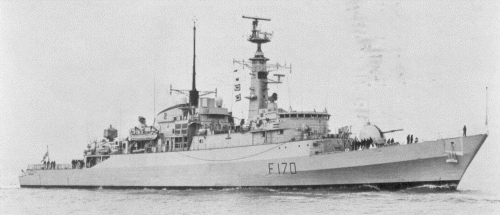
NAVYPEDIA
 Support the project with paypal
Support the project with paypal
Photo

Antelope 1981
Ships
| Name | No | Yard No | Builder | Laid down | Launched | Comp | Fate |
|---|---|---|---|---|---|---|---|
| Amazon | F169 | 4228 | Vosper Thornycroft, Woolston | 6.11.1969 | 26.4.1971 | 11.5.1974 | to Pakistan 9.1993 (بابر [Babur]) |
| Antelope | F170 | 4232 | Vosper Thornycroft, Woolston | 23.3.1971 | 16.3.1972 | 16.7.1975 | sunk 24.5.1982 |
| Active | F171 | 4233 | Vosper Thornycroft, Woolston | 21.7.1971 | 23.11.1972 | 17.6.1977 | to Pakistan 9.1994 (شاہ جہاں [Shah Jahan]) |
| Ambuscade | F172 | 1008 | Yarrow SB, Scotstoun | 1.9.1971 | 18.1.1973 | 5.9.1975 | to Pakistan 7.1993 (طارق [Tariq]) |
| Arrow | F173 | 1009 | Yarrow SB, Scotstoun | 28.9.1972 | 5.2.1974 | 29.7.1976 | to Pakistan 3.1994 (خیبر [Khaibar]) |
| Alacrity | F174 | 1010 | Yarrow SB, Scotstoun | 5.3.1973 | 18.9.1974 | 2.7.1977 | to Pakistan 3.1994 (بدر [Badr]) |
| Ardent | F184 | 1011 | Yarrow SB, Scotstoun | 26.2.1974 | 9.5.1975 | 14.10.1977 | sunk 22.5.1982 |
| Avenger | F185 | 1012 | Yarrow SB, Scotstoun | 30.10.1974 | 20.11.1975 | 15.4.1978 | to Pakistan 9.1994 (تیپپو سلطان [Tippu Sultan) |
Technical data
| Displacement standard, t | 2750 |
|---|---|
| Displacement full, t | 3250 |
| Length, m | 109.7 wl 117.0 oa |
| Breadth, m | 12.7 |
| Draught, m | 6.00 screws |
| No of shafts | 2 |
| Machinery | COGOG: 2 Rolls-Royce Olympus TM3B gas turbines / 2 Rolls-Royce Tyne RM1A gas turbines |
| Power, h. p. | 56000 / 8500 |
| Max speed, kts | 30 |
| Fuel, t | gas turbine oil |
| Endurance, nm(kts) | 4000(17) |
| Armament | F169, 170: 1 x 4 Sea Cat GWS24 SAM (12 Sea Cat), 1 x 1 - 114/55 Mk 8, 2 x 1 - 20/70 Mk 7, 1 helicopter (Wasp) F171-174, 184, 185: 4 x 1 Exocet MM38 SSM (4 MM38/GWS50), 1 x 4 Sea Cat GWS24 SAM (12 Sea Cat), 1 x 1 - 114/55 Mk 8, 2 x 1 - 20/70 Mk 7, 1 helicopter (Lynx) |
| Electronic equipment | type 992Q, 2x type 912, type 978 radars, type 184M, type 162M sonars, UAA(1) ECM suite, 2x Corvus decoy RL, type 182 torpedo decoy, CAAIS DBA-2 CCS |
| Complement | 175 - 192 |
Standard scale images

Arrow 1980
Graphics
Project history
The Type 21 design had its origin in the need to replace the diesel-engined frigates of the Leopard and Salisbury classes. At the same time private shipbuilders were lobbying for a chance to build a frigate for the RN without what they claimed to be excessively high standards imposed by the MoD's Ship Department at Bath. It was claimed that such a frigate would not only be cheaper (£3.5m as against £5m for a Leander at contemporary prices), but also a good export item. The Controller of the Navy backed this claim wholeheartedly, even to the point of trying to cut the Ship Department out of the design process.
The result was a wasted opportunity to bring private and official designers together. Details of the design did not meet certain naval requirements, the cost was £14.4m for the first ship, and the vessels lacked sufficient 'stretch' to take the next generation of weapons (specifically the Type 2016 sonar, a long-range radar and the Sea Wolf missile). They were popular with the RN, however, particularly because of their comfortable officers' accommodation (in contrast, the ratings' accommodation was below the standard in contemporary RN ships) and because they handled easily.
From Active onwards, four MM38 Exocet SSMs were fitted in 'B' position, toed inwards to allow the blast to vent outboard to port and starboard. The triple STWS-1 close-range torpedo defence was also fitted after completion. The fire control system was a new departure: as no suitable British light system existed, the RN bought the Italian Selenia RTN-10X radar tracker and combined it with the British Ferranti WSA-4 below-decks equipment, providing control for both the 114mm gun and the Seacat GWS24. Although there was talk of the design allowing the replacement of Sea Cat by Sea Wolf this was never possible because the ships were delivered overweight and did not have the margin of stability necessary for such a big system. A Lynx helicopter armed with lightweight torpedoes was carried.
The Royal Australian Navy contributed a large sum (believed to be about 35%) to the design costs, with the intention of building five ships in Australian yards; this project never came to fruition, however, and although Argentina showed some interest, no export orders were ever won for this design, In 1980 it was confirmed that the class would not receive a modernization, but all six survivors were stiffened post-1982.
In 1977 in the Far East Amazon suffered a bad fire, and this drew attention to the risk of building warships with all-aluminium superstructures, a risk underlined by the Falklands conflict. The designers maintained that they could not have met the requirement to raise the weapon load without saving as much topweight as possible. To this their critics replied that the flimsiness of aluminium accentuates the vulnerability of modem warships to relatively minor damage. Whatever the merits of the argument, after the construction of the Amazon class the British Naval Staff changed their minds about aluminium, and stipulated that future ships use steel only.
Modernizations
1980-1982, all: - 1 Wasp helicopter, type 978 radar; + 2 x 1 - 20/70 Mk 7, 2 x 3 - 324 STWS.2 TT, 1 Lynx helicopter, type 1006 radar
1985, Amazon: + 4 x 1 Exocet MM38 SSM (4 MM38/GWS50)
late 1980s, all: - type 992Q radar, type 184M sonar; + type 992R radar, type 184P sonar
late 1980s, Arrow, Avenger: + 2x type 670 ECM suites
Naval service
During the Falklands conflict Ardent was badly damaged by air-launched unguided rockets on 21 May 1982 and sank shortly afterwards; Antelope was hit by bombs on 23 May, and blew up on the following day while an explosives expert was trying to defuse an unexploded bomb.
 HOME
HOME FIGHTING SHIPS OF THE WORLD
FIGHTING SHIPS OF THE WORLD UNITED KINGDOM
UNITED KINGDOM ESCORTS
ESCORTS AMAZON frigates (1974 - 1978)
AMAZON frigates (1974 - 1978)

